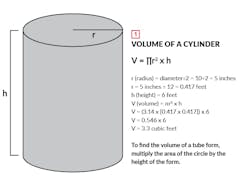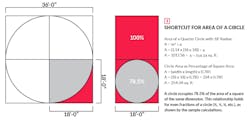Estimating Shortcuts for Circular Concrete Shapes
When it comes to estimating concrete quantities, most remodelers rely on a quote from a subcontractor. But occasionally it’s easier to estimate the costs yourself for a small job, such as a patio slab or a group of concrete piers to support a deck. Both of those examples involve calculating volume of concrete needed, which is simple enough for a rectangular slab, but a bit more complicated for a cylindrical tube form or a semi-circular patio.
These days, you can key a few numbers into an online calculator that will spit out the quantity of concrete needed. But the math behind the calculation is easy, and it won’t hurt to be reminded how to make the calculation manually just in case your WiFi is on the blink. Plus, I just discovered a cool shortcut that’s worth knowing.
Volume of a Cylinder: #TheHardWay
A tube form is a tall, skinny cylinder, and a circular slab is a short, wide cylinder. As with all cylinders, calculating volume (V) requires multiplying the area of a circle (πr2) by the height (h). Let’s look first at a 10-inch tube form that’s 6 feet tall. To find the volume, you must: 1) find the radius; 2) convert inches to feet; and 3) plug the results into the formula V = πr2 x h [1].
The Shortcut
Okay, that was fun, but it’s a lot easier to consult a table of common tube form diameters and the amount of concrete needed to fill them per foot of height [2].
Of the many instructional videos available at the company’s website and YouTube channel, this one is about calculating the amount of concrete needed for a curved patio slab. In it, Odell reveals a shortcut that I’d never seen before: The area of a circle is 78.5% the area of a square of the same dimension. Let’s look at an example.
Odell refers to drawings of a pie-shaped patio slab that projects 18 feet out from the house. The slab is a perfect quarter circle and, using his shortcut, he finds the area by taking a square of the same size, then multiplying by 0.785 to find the area of the pie shape [3]. All that’s left to get the volume is to multiply by the thickness of the slab, which in this case is 4 inches. To actually order the concrete, of course, you have to convert to cubic yards.
Shortcutting the Tube
Coming full circle, as it were, this little trick also works with concrete tube forms. Returning to the earlier example of a 10-inch-diameter tube form, the area of a 10-inch square is 100 square inches (10 x 10) or 0.69 square feet (100/144). Multiply that by 0.785, and you get 0.545 square feet for the area of the 10-inch circle formed by the tube. The volume of a 6-foot-tall tube is still 3.3 cubic feet (0.545 x 6).
Pretty slick.
Get more Jobsite Know-How here
About the Author
Sal Alfano
Executive Editor
Sal Alfano is executive editor for Professional Remodeler. [email protected], 202.365.9070



